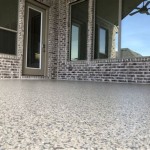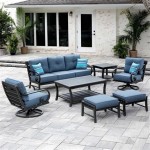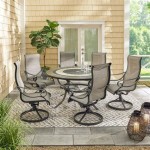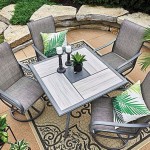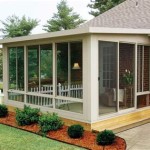How To Secure Patio Cushions: A Comprehensive Guide
Patio furniture enhances outdoor living spaces, providing comfort and style. However, the cushions that adorn this furniture are often vulnerable to displacement by wind, rain, and even playful animals. Securing patio cushions is essential not only to maintain their appearance and prevent damage, but also to ensure user comfort and safety. This article provides a detailed guide on various methods and strategies to effectively secure patio cushions, prolonging their lifespan and enhancing the overall outdoor experience.
Understanding the Challenges of Securing Patio Cushions
Before exploring the different methods of securing patio cushions, it's important to understand the challenges involved. The primary challenge is the unpredictable nature of the outdoor environment. Wind gusts can easily lift and carry unsecured cushions, especially lightweight ones. Rain can saturate cushions, making them heavier and more susceptible to mold and mildew if not properly dried. Furthermore, direct sunlight can fade and degrade the fabric over time. Finally, curious animals can chew on or nest in unsecured cushions, leading to damage and unsanitary conditions.
The material of the cushions and the furniture frame also play a significant role. Cushions made from lightweight materials are more prone to being blown away. Furniture frames with smooth surfaces offer less friction, making it easier for cushions to slide off. The size and shape of the cushions also contribute to the difficulty of securing them; larger cushions present a greater surface area for the wind to act upon, while oddly shaped cushions may not fit snugly within the furniture frame.
Therefore, a comprehensive approach to securing patio cushions must address these challenges through a combination of methods that provide both physical restraint and environmental protection.
Methods of Physically Securing Patio Cushions
Physical securing methods aim to directly attach the cushions to the furniture frame, preventing them from being blown away or sliding off. These methods range from simple temporary solutions to more permanent alterations.
One of the simplest and most widely used methods involves using Velcro straps or strips. Velcro is available in both adhesive and sew-on versions. Adhesive Velcro can be directly attached to the underside of the cushion and the corresponding area on the furniture frame. Sew-on Velcro requires a bit more effort, but it provides a more secure and durable bond, especially for cushions that experience heavy use. Velcro provides a strong enough hold to withstand moderate winds, while still allowing for easy removal of the cushions for cleaning or storage.
Another option is to use cushion ties. These are fabric or rope ties that are sewn onto the corners or sides of the cushions. The ties are then wrapped around the furniture frame and tied securely. Cushion ties are particularly effective for securing cushions to chairs or benches with open frames. They offer a classic and aesthetically pleasing look, while providing a reliable hold. It's important to use durable, weather-resistant materials for the ties to ensure they can withstand outdoor conditions.
For a more permanent solution, consider using screws or bolts to attach the cushions to the furniture frame. This method involves drilling small holes through the cushion and into the frame, then securing the cushion with screws or bolts. While this provides the strongest hold, it also requires careful planning and execution to avoid damaging the cushion or the furniture frame. It's important to use rust-resistant hardware to prevent corrosion and staining. This method is best suited for cushions that are not frequently removed.
Bungee cords or elastic straps can also be used to secure patio cushions. These cords are stretched around the cushion and attached to the furniture frame using hooks or clips. Bungee cords provide a flexible and adjustable hold, allowing for some movement while still preventing the cushion from being blown away. They are particularly useful for securing cushions to curved or irregularly shaped furniture frames. Choose bungee cords with UV-resistant coating to prevent them from deteriorating in sunlight.
Finally, consider using cushion grips or non-slip mats. These are placed between the cushion and the furniture frame to increase friction and prevent the cushion from sliding. Cushion grips are particularly effective for furniture frames with smooth surfaces. They are a simple and inexpensive solution that requires no permanent alterations to the cushions or the furniture frame. However, they may not be sufficient in strong winds.
Environmental Protection and Storage Strategies
In addition to physical securing methods, environmental protection and proper storage are crucial for maintaining the condition of patio cushions and preventing them from becoming dislodged. These strategies focus on minimizing exposure to harsh weather conditions and providing secure storage when the cushions are not in use.
Investing in high-quality patio furniture covers is a worthwhile investment. These covers are designed to protect the furniture, including the cushions, from rain, wind, sun, and other environmental elements. Choose covers that are made from waterproof and UV-resistant materials. Ensure the covers fit snugly over the furniture to prevent wind from getting underneath. Regular use of patio furniture covers can significantly extend the lifespan of the cushions and reduce the need for frequent cleaning.
When not in use, store the cushions in a dry and secure location. This could be a shed, garage, or even a large storage bin. Storing cushions indoors during periods of inclement weather or when the furniture is not in use can prevent them from becoming wet, faded, or damaged. Ensure the cushions are completely dry before storing them to prevent the growth of mold and mildew. Consider using a dehumidifier in the storage area to further reduce moisture levels.
For cushions that are left outdoors, consider using water-repellent sprays. These sprays create a protective barrier on the fabric, preventing water from soaking into the cushion. Reapply the spray regularly, especially after heavy rain or cleaning. Choose a water-repellent spray that is specifically designed for outdoor fabrics and follow the manufacturer's instructions for application.
Regular cleaning and maintenance are also essential for prolonging the lifespan of patio cushions. Remove dirt, debris, and spills promptly to prevent staining and damage. Use a mild soap and water solution to clean the cushions, and rinse thoroughly. Allow the cushions to air dry completely before storing or using them. For stubborn stains, consider using a specialized fabric cleaner. Regularly inspect the cushions for signs of wear and tear, and repair any damage promptly to prevent it from worsening.
Positioning the patio furniture strategically can also help to reduce the risk of cushions being blown away. Place the furniture in a sheltered area, such as under a covered porch or near a fence. This will provide some protection from the wind and rain. Avoid placing the furniture in exposed areas that are directly exposed to strong winds.
Choosing the Right Materials and Construction
The materials used in the construction of patio cushions play a significant role in their durability, weather resistance, and susceptibility to being displaced. Selecting the right materials can minimize the challenges associated with securing patio cushions and prolong their lifespan.
Choose fabrics that are specifically designed for outdoor use. These fabrics are typically water-resistant, UV-resistant, and fade-resistant. Common outdoor fabrics include solution-dyed acrylic, polyester, and olefin. Solution-dyed acrylic is known for its excellent colorfastness and resistance to mildew. Polyester is a durable and affordable option that is easy to clean. Olefin is a lightweight and stain-resistant fabric that is suitable for high-traffic areas. Avoid using cotton or other natural fibers, as they are more prone to water damage and mildew.
The filling material of the cushions also affects their weight and stability. Choose filling materials that are quick-drying and resistant to mold and mildew. Common filling materials include polyurethane foam, polyester fiberfill, and shredded foam. Polyurethane foam provides good support and is relatively inexpensive. Polyester fiberfill is lightweight and dries quickly. Shredded foam provides a more relaxed and comfortable feel. Avoid using down or other natural fillings, as they are more prone to water damage and mold.
Consider the construction of the cushions. Cushions with zippered covers are easier to clean and maintain. Look for cushions with reinforced seams and durable stitching. Some cushions also have built-in drainage holes to allow water to escape. Cushions with a higher density filling will be heavier and less likely to be blown away. Cushions that are designed to fit snugly within the furniture frame will also be more secure.
When purchasing new patio furniture, consider selecting furniture with built-in cushion securing features. Some furniture sets come with straps, ties, or clips that are specifically designed to hold the cushions in place. This can eliminate the need for additional securing methods. Alternatively, you can modify existing furniture to add these features.
By carefully considering the materials and construction of patio cushions, and by implementing a combination of physical securing methods, environmental protection strategies, and proper storage techniques, it is possible to effectively secure patio cushions and enjoy a comfortable and worry-free outdoor living space.

8 Ways To Keep Outdoor Cushions From Blowing Away

8 Ways To Keep Outdoor Cushions From Blowing Away

How To Keep Outdoor Cushions From Blowing Away Sliding

10 Ways To Keep Patio Furniture Secure When The Wind Blows Sunnydaze Decor

S For Outside

The Brilliant To Keep Your Outdoor Cushions In Place On A Windy Day

13 Simple Ways To Attach Cushions Patio Furniture

How To Secure Patio Furniture From The Wind 11 Easy Ways

How To Secure Back Seat Cushions Patio Furniture Youtube

Ways To Secure Your Outdoor Furniture From Strong Winds

